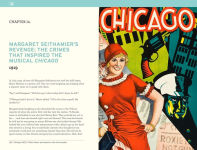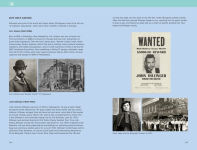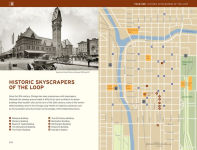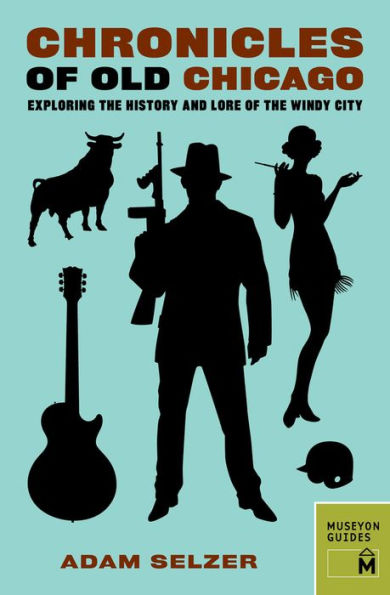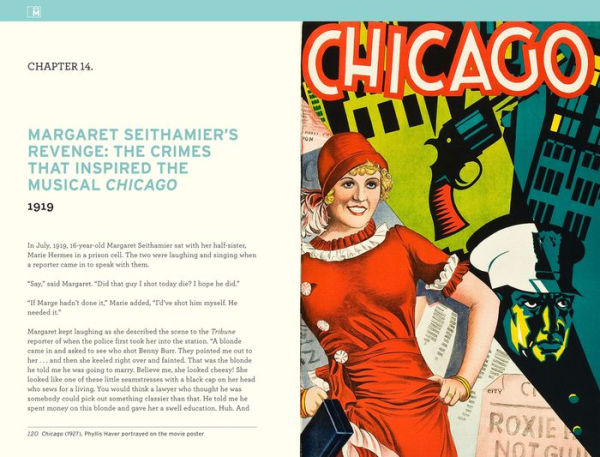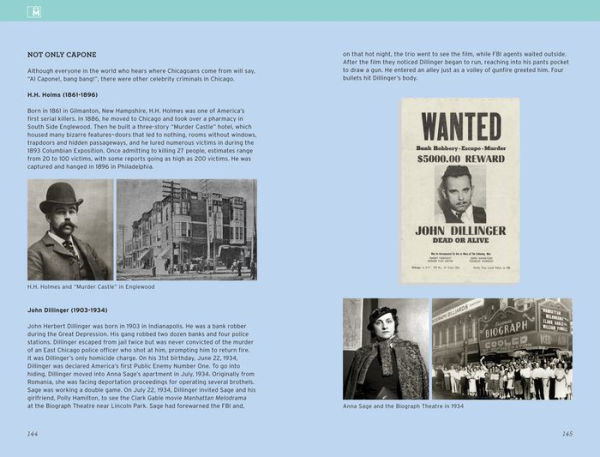
Chronicles of Old Chicago: Exploring the History and Lore of the Windy City
272
Chronicles of Old Chicago: Exploring the History and Lore of the Windy City
272Paperback
-
SHIP THIS ITEMIn stock. Ships in 1-2 days.PICK UP IN STORE
Your local store may have stock of this item.
Available within 2 business hours
Related collections and offers
Overview

Product Details
| ISBN-13: | 9780984633487 |
|---|---|
| Publisher: | Museyon |
| Publication date: | 07/01/2014 |
| Series: | Chronicles Series |
| Pages: | 272 |
| Product dimensions: | 7.90(w) x 5.20(h) x 0.70(d) |
About the Author
Read an Excerpt
Chronicles of Old Chicago
Exploring the History and Lore of the Windy City
By Adam Selzer
Museyon, Inc.
Copyright © 2014 Adam SelzerAll rights reserved.
ISBN: 978-1-938450-71-6
CHAPTER 1
THE BATTLE OF FORT DEARBORN: HOW THE WORLD FIRST HEARD OF THIS PLACE CALLED CHEEKAGEAUXS
1812
In 1816, when soldiers came to the area known as "Chicageaux" to build a new Fort Dearborn — named for Henry Dearborn, who was secretary of war from 1801-09 — they were greeted with an unpleasant sight: the bones of the soldiers who had founded the old fort, which had been bleaching in the sun since the day the first fort was burned to the ground.
At the time of the War of 1812, the space that would one day be Chicago was hardly a major outpost; it was just a place where the river met Lake Michigan, a region that the local Potawatomi Indians called "Eschecagou" (or any of a dozen other spellings), which referred to the foul smell of wild onions and garlic that hovered over the area. There was a fort there, but only a small and poorly armed one that stood on the edge of what was then a nearly unimaginable wilderness — even a generation later, you could still go hunting for big game just as close to the city as the present site of Halsted Street, just blocks west of the Loop, the main downtown area. Besides a few settlers who lived near the mouth of the river, and many Potawatomi Indians who lived in the vicinity, the soldiers of the fort and their families — just over a hundred people — were among America's last lines of defense of the frontier.
The first non-native to settle in the area was Jean Baptiste Point du Sable, about whom fairly little is known. In the late 1770s he was arrested on suspicion of sympathizing with the colonists in the Revolutionary War (which was illegal when the colonies were still colonies), but it is unclear what brought him to Chicago, where he settled around the 1780s. Some suggest that he was a Caribbean pirate on the run from the law. That may seem far-fetched, but it is probably as good an explanation as any for why he, or anyone else, would have settled in what was then such a desolate place.
Most stories about his early life, parentage, and origins are guesswork at best, and impossible to authenticate today, though it's generally agreed that he was at least part African-American. People who knew him described him as handsome and well-educated. Traders passing through the area where he lived were known to buy goods from him; he had his own farm, flour mill, dairy, two barns, a chicken coop and a smoke house. The cabin he shared with his Potawatomi wife was spacious, comfortably appointed, and well decorated. He moved on from the area in 1800, allegedly because the local tribes wouldn't make him chief, probably never dreaming that a monument on the site of his cabin would one day designate him as the "founder of Chicago." After all, there was no Chicago there yet!
Point du Sable sold his house to one Jean La Lime, a trader, who immediately became a fierce rival of the other local trader, John Kinzie (whose social-climbing daughter-in-law would work hard to make future generations refer to him as the founder of the city). In those days, the market for a trading post was minimal; few trappers came through the area, so competition for the two men got fierce. Eventually, the rivalry became deadly when Kinzie killed La Lime in 1812.
Now, what actually happened between the two men is not exactly known. The official story was that La Lime attacked Kinzie, shooting him in the shoulder, and Kinzie was acting in self-defense when he stabbed La Lime to death. Many, however, doubt the story — few men who have been shot in the shoulder are in good enough shape to stab a man to death in the moments after the shooting. Many modern historians think that the fight between the two was really just a drunken brawl between a couple of prairie ruffians, and speculate the soldiers at the fort had been annoyed with La Lime, who perhaps was threatening to expose corruption within the fort.
Life at the fort went on like this, with minor dramas and fights, until the War of 1812, when tensions between early Americans and the British turned into a second war against the two nations. When word came that the British soldiers (whose support of Native American tribes against American expansion was one of the sore points that sparked the war) were marching on Fort Dearborn, orders came in to evacuate — the little fort had nowhere near the supplies to fight back the British Army. Arrangements were made for the settlers and their families to set out on foot for Fort Wayne, but they never made it more than a couple of miles from the city before being attacked by the Potawatomi.
Determining the true history of what happened at The Battle of Fort Dearborn — otherwise known as the Fort Dearborn Massacre — has frustrated historians; several first- and second-hand accounts were written of the horrific fight, but no one seemed to be able to retell the story without trying to make themselves look like a hero. From comparing different accounts, though, we can put some of the basics together.
Having received orders to evacuate the fort before the British Army could arrive, the captain of the fort, Nathan Heald, met with the Potawatomi and offered them a deal: if they would accompany the soldiers and their families to Fort Wayne, the settlers would give them all their guns, all their ammunition, and all of their whiskey.
The Potawatomi agreed to the deal, but the other officers in the fort thought that Heald had lost his mind — tensions between the settlers and the tribe had been running high, and he had just offered potentially hostile people guns, ammunition, and liquor. Heald agreed that it had been a bad idea, and the weapons were thrown down a well. The whiskey was poured into the river in such quantities that people noted that the drinking water tasted of "strong grog" the next day.
Perhaps the Potawatomi saw the settlers destroying the goods they had promised them and decided that the passage to Fort Wayne would not be a safe one. Or, they may have decided that before.
Shortly before the group set off, Captain William Wells had arrived.
Raised by the Miami Tribe himself, Wells was something of a legend among the frontiersmen; he was said to speak several Native American languages. His niece, Rebecca, was married to Captain Nathan Heald, and he, along with a small band of Miami warriors, had come to help the settlers move.
In any case, when the settlers set off for Fort Wayne accompanied by a band of Potawatomi warriors, they only got a mile south — down to the present day site of 18th Street and Prairie Avenue — before the warriors turned on the settlers and attacked them.
The battle only lasted about fifteen minutes — the settlers and the Miami were greatly outnumbered by the Potawatomi.
Margaret Helm, the wife of a fort lieutenant, found Dr. Van Voorhees, the fort surgeon, lying wounded in the sand, and as the battle raged on, he suggested to her that they surrender and beg for their lives.
"Dr. Voorhees," said Mrs. Helm, "do not let us waste the moments that yet remain to us in such vain hopes. Our fate is inevitable. In a few moments we must appear before the bar of God. Let us make what preparation is yet in our power."
"Oh, I cannot die!" shouted Voorhees. "I am not fit to die if I had but a short time to prepare. Death is awful!"
Helm pointed out Ensign George Ronan, who was fighting with his last breath, though he was mortally wounded. "Look at that man," she said. "At least he dies like a soldier!"
"Yes," said the doctor, "but he has no terrors of the future. He is an atheist!"
Just at that moment, a warrior raised his tomahawk over Mrs. Helm, and she rolled away just in time for it to hit her shoulder instead of her head. The chief of the Potawatomi warriors, Black Partridge, grabbed her and took her to the safety of the nearby lake.
Or, anyway, that was the way Mrs. Helm told the story. Whether it was real or strictly fiction on her part is anyone's guess (though Dr. Voorhees did, in fact, die in the battle).
When she was led to safety, Helm claimed to see another warrior holding a scalp, which she recognized as that of Captain William Wells. He had been shot in the back and killed in the battle; several accounts say that his heart was cut out and eaten by other warriors as a tribute to his courage.
The 500 warriors greatly outnumbered the hundred-odd settlers and soldiers. Within only 15 minutes, around 50 of the soldiers and settlers were killed, and the survivors were captured and sold as slaves to the British (who, to their credit, promptly let them go). The fort was burned to the ground, and the bodies of several settlers were left to rot on the dunes.
Word of the battle was the first many people would hear of the little village called Chicago.
The borders of the Fort are marked with plaques on the ground near the corner of Wacker Drive and Michigan Avenue, right at the foot of what is now the Magnificent Mile. It's almost impossible to imagine that only two centuries ago it was the edge of the frontier.
CHAPTER 2CHICAGO IS BORN: FROM MUDHOLE TO METROPOLIS
1837
People joking about Chicago elections often say that the slogan is to "Vote Early, Vote Often." According to legend, that practice goes all the way back to the founding of the city. When the settlers voted to incorporate as a city in 1837, 150 votes were needed, but only 140 people showed up to vote. To get to the "magic number," ten of the men simply voted twice.
This would have been in the 1830s, when Chicago was still not even big enough to be called "the mudhole of the prairie." By then, it had been inhabited by settlers for more than a quarter of a century, but growth was coming in fits and starts. It was hard to imagine back then just how rapidly the city would soon grow; it took human civilization thousands of years to produce a city with a million residents, and Chicago went from nearly zero to more than a million in just over half a century.
By 1833, the little village had reached a population of around 200 settlers and traders, none of whom imagined that the little village they had settled in would be a sprawling metropolis within their lifetimes, though many land speculators moved in with a hunch that the tracts of land near the river and lake would one day be far more valuable. In that year, the Treaty of Chicago moved the native tribes to a new five-million acre reservation west of the Mississippi, and travelers described the settlement as an important trading center where locals did business with settlers who were heading farther west. But, though it was becoming an important town, in its way, it was still not exactly a pretty one — it was still little more than a conglomeration of shacks set up in the mud at the mouth of the river. One traveler described "a chaos of mud, rubbish and confusion. Frame and clapboard houses were springing up daily under the active axes and hammers of the speculators, and piles of lumber announced the preparation for yet other edifices of an equally light character."
By this time, the city had several stores, a couple of doctors, five or six hotel keepers, and a steady stream of transient residents, some of whom impressed witnesses as "sharpers'" (con men) "of every degree." Most grocery stores really only sold whiskey. At least one hotel, though, the Sauganash, was known as fairly plush by the standards of the day. It stood at the present site of Wacker and Lake Street, and the five-block journey to the main fort was usually made by river, as the roads were so muddy that they were impossible to walk through.
It's a wonder, really, that there was anyone left in town by then, as 1831 was described as "the winter of deep snow," when snow was four feet deep and the temperature hovered at 15 below for three weeks. Freezing to death was one of the most common causes of death, if not the most common of all, and it's remarkable that any survived it at all. The cold served at least one useful purpose, though; when ice formed on the lake, the businesses in town would close for a day and all of the wolves in the woods would be driven out to the ice to be shot. This was one of the most festive days of the year.
By 1831, Chicago was already the county seat of Cook County, but was not yet officially a town at all. In that year, a law was passed saying that an area could become a town if the population reached 150, and two years later it met the requirement.
The legend that only 140 showed up to vote, prompting 10 to vote twice, seems to be just that — a legend. The rule was that you needed 150 people, not 150 votes. On August 3rd, Justice of the Peace Ralph E. Hickok presided over a meeting of the citizens of Chicago at the Sauganash Tavern about incorporating, and a vote was held among those present. Twelve men voted to incorporate, and only Hickok himself voted against it. The resolution to incorporate as a town was adopted. Four years later, it was incorporated as a full-fledged city. William Ogden was elected mayor, beating out John Kinzie's son for the title.
By 1840, the population of Chicago had reached 4,000. The construction of the Illinois-Michigan canal brought in scores of men looking for work, and made the area economically viable. Speculators bought up broad parcels of land in something of a frenzy.
John Wentworth, an early mayor, later noted that most new settlements can be pointed out by "a particular class," such as the Puritans in New England or the Creoles of New Orleans. But Chicago had no such class — it was a broad mix of races, religions, classes and creeds. In many ways it was the most American of cities.
By the time of the World's Fair in 1893, when Chicago truly announced itself to the world as a major city, there were still people alive in town who remembered the city as it had been when they were children: simply a small collection of wooden houses on the muddy prairie. None could have dreamed that their little town would become the greatest metropolis of the Midwest.
CHAPTER 3THE LAGER BEER RIOTS: CHICAGO GETS WHAT IT DESERVES FOR ELECTING A MAYOR FROM THE "KNOW NOTHING" PARTY
1855
Chicago has long been known for the battles fought between forces of the law and people who just wanted to have a drink. The battle between bootleggers and gangbusters in the 1920s is a part of what defined the modern era's perception of the city.
But few realize that the city's first battle for legal drinking came decades before, in 1855.
Chicago always had a flair for electing strange mayors — people with names like Long John and Big Bill. Elected in 1915, William Hale Thompson, known as Big Bill, displayed antics and buffoonery, in particular, such as hosting debates with rodents standing in for his opponents, which earned him a place in Chicago history, if not exactly a place of honor.
(Continues...)
Excerpted from Chronicles of Old Chicago by Adam Selzer. Copyright © 2014 Adam Selzer. Excerpted by permission of Museyon, Inc..
All rights reserved. No part of this excerpt may be reproduced or reprinted without permission in writing from the publisher.
Excerpts are provided by Dial-A-Book Inc. solely for the personal use of visitors to this web site.
Table of Contents
Contents
CHAPTER 1. THE BATTLE OF FORT DEARBORN: How the World First Heard of This Place Called Cheekageauxs 1812,CHAPTER 2. CHICAGO IS BORN: From Mudhole to Metropolis 1837,
CHAPTER 3. THE LAGER BEER RIOTS ON THE CLARK STREET BRIDGE: Chicago Gets What it Deserves for Electing a Mayor From the Know Nothing Party 1855,
CHAPTER 4. ABRAHAM LINCOLN COMES TO CHICAGO: Chicago Was Almost a Second Home to the Sixteenth President 1858-60,
CHAPTER 5. THE STOCKYARDS THAT MADE CHICAGO: How Chicago Got the Name "The Hog Butcher for the World" 1864-1971,
CHAPTER 6. THE GREAT CHICAGO FIRE: The Tragedy that Became a New Beginning 1871,
CHAPTER 7. LINCOLN PARK: How Many Chicagoans Know that Their Favorite Park Was Once a Graveyard? 1865,
CHAPTER 8. CAPTAIN STREETER: Barely a Century Ago the Magnificent Mile was Still Called Shantytown 1886-1918,
CHAPTER 9. JANE ADDAMS: The Devil Baby Who Made Hull House Famous 1889,
CHAPTER 10. BATHHOUSE JOHN, HINKY DINK KENNA, AND THE FIRST WARD BALL: Crooked Politics Becomes Great Entertainment 1896-1908,
CHAPTER 11. LOUIS SULLIVAN: President Roosevelt's Speech at the Acoustically Perfect Auditorium Theatre 1903,
CHAPTER 12. WHEN CHICAGO WAS HOLLYWOOD: At One Time in the Silent Era, Chicago Was the Film Capital of the World 1907-20,
CHAPTER 13. THE BLACK SOX SCANDAL: The Shocking Story That Nearly Destroyed Baseball 1919,
CHAPTER 14. MARGARET SEITHAMIER'S REVENGE: The Crimes that Inspired the Hit Musical Chicago 1919,
CHAPTER 15. LILLIAN COLLIER AND THE SNUGGLEPUPPIES: A Young Flapper's Crusade to Bring High Art to Chicago 1922,
CHAPTER 16. THE SAINT VALENTINE'S DAY MASSACRE: The Most Famous Event in Chicago Gangland History 1929,
CHAPTER 17. RESURRECTION MARY: Chicago's Most Famous Ghost — The Vanishing Hitchhiker of Archer Avenue 1930s,
CHAPTER 18. THE CURSE OF THE CUBS: Is the Cubs' Long Losing Streak Really Because of a Goat? 1945,
CHAPTER 19. THE LADY IN BLACK AT THE DRAKE HOTEL: Murder Amid the Glamour Beside the Lake 1944,
CHAPTER 20. BUGHOUSE SQUARE: Where People Tried to Change the World from Atop a Soapbox 1947,
CHAPTER 21. CHESS RECORDS AND THE CHICAGO BLUES: There Was No Other Sound Like the Chess Records Sound 1950-75,
CHAPTER 22. MAYOR DALEY THE FIRST: 7,183 Days of the Last of the Big City Bosses 1955-76,
CHAPTER 23. OPRAH AND EBERT AT THE MOVIES: Two Chicago Icons and the Date That Made History 1986,
CHAPTER 24. BARACK OBAMA, CHICAGO PRESIDENT: His Election Night Rally in Grant Park Made History 2008,
WALKING TOURS,
TOUR ONE HISTORIC SKYSCRAPERS OF THE LOOP,
TOUR TWO RIVER WALK,
TOUR THREE THEATER DISTRICT,
TOUR FOUR LINCOLN PARK,
TOUR FIVE THOUSAND-FOOT BUILDINGS,
TOUR SIX THE MICHIGAN AVENUE CLIFF,
INDEX,

